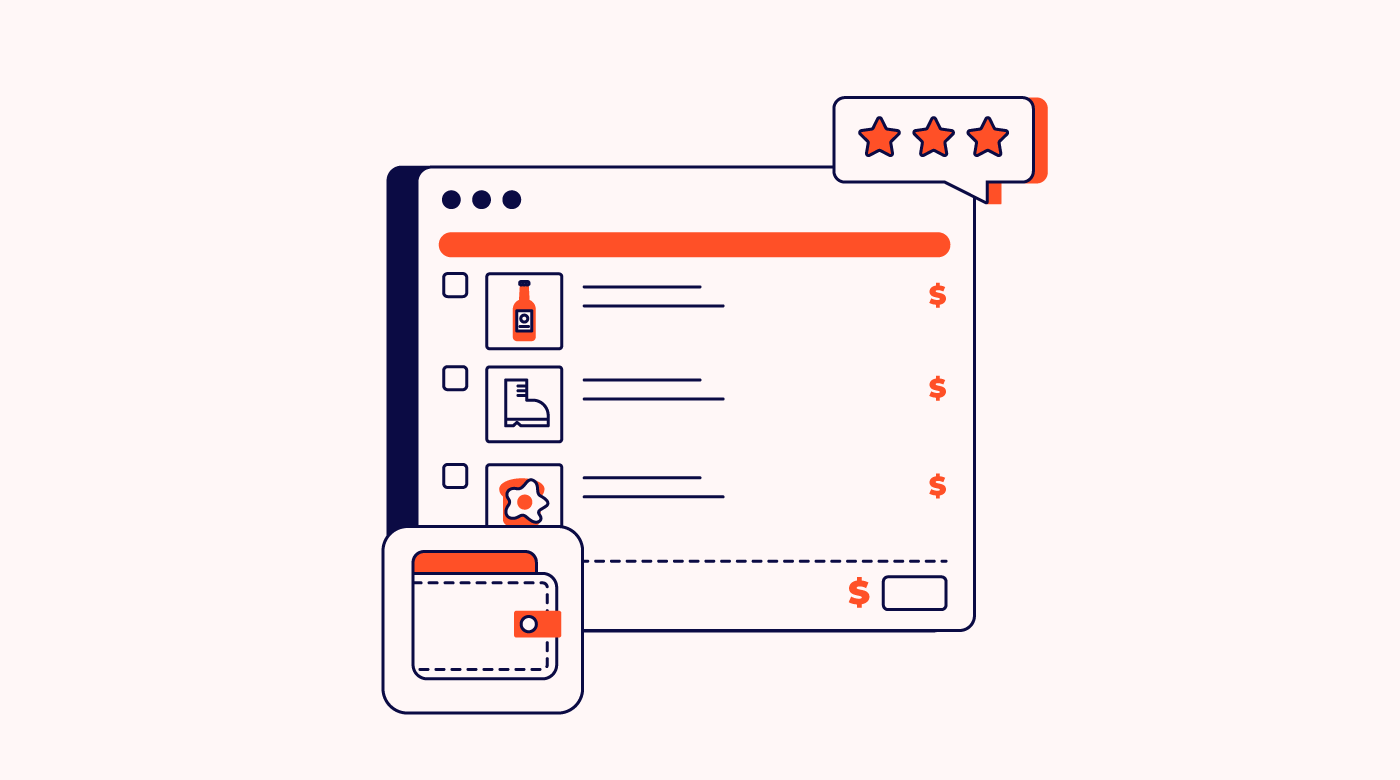As an ecommerce expert, I’ve seen the struggles and triumphs businesses experience when it comes to the crucial moment of conversion: the checkout. So often, customers abandon their carts, leaving us scratching our heads, wondering what went wrong. I’ll share advanced shopping cart design secrets in this article that can transform your checkout process. I’ll explore the intricate web of user experience, design psychology, and streamlined functionality to solve the perennial problem of abandoned carts.
You can expect a deep dive into optimizing user interfaces, leveraging persuasive design techniques, and harnessing the power of seamless navigation to elevate your checkout game and keep customers clicking that “Complete Purchase” button.
What Is A Shopping Cart Page?
The shopping cart page is a digital junction where customer intent meets the journey toward purchase. It’s the virtual holding ground for items carefully chosen by shoppers, a dynamic hub where products selected from your store converge for evaluation and finalization.
This page showcases a curated collection of desired items, offering users a comprehensive overview of their selections before venturing into the checkout process. It’s more than just a repository; it’s a pivotal stage where decisions solidify, quantities adjust, and the bridge between browsing and ownership takes shape.
Understanding The Importance Of Your Shopping Cart Page
Your shopping cart isn’t just a placeholder - it’s a strategic linchpin in your ecommerce success, making it a pivotal determinant in customer retention and conversion rates. Understanding its crucial role is the first step toward unlocking its immense potential in securing satisfied customers and bolstering sales.
The Role of the Shopping Cart in the Customer Journey
The online shopping cart is the pivotal crossroads in the captivating odyssey of a customer’s journey. It’s more than a mere container for products; it symbolizes choice, intention, and anticipation. From the initial spark of interest to the decisive moment of purchase, the cart serves as a navigational beacon, a sanctuary where browsing transitions into commitment. It encapsulates the essence of a shopper’s preferences and desires, offering a curated space for reflection, adjustment, and validation before the final step toward ownership. In the digital space, the online shopping cart becomes the custodian of decisions, the bridge between exploration and acquisition, and an indispensable companion throughout the customer’s engaging expedition.
Impact on Conversion Rates and Customer Retention
Your online shopping cart acts as a silent hero in ecommerce, wielding immense power over conversion rates and customer loyalty. Its optimized design and functionality can be the cornerstone between a fleeting visitor and a committed buyer, orchestrating straightforward transitions from interest to purchase.
A well-crafted cart experience simplifies the checkout process, reduces abandonment rates by up to 35.62%, and fosters a sense of trust and convenience, elevating the overall customer journey. By nurturing a user-friendly environment where decisions are easily made and actions swiftly executed, an adept shopping cart catalyzes conversion success and imprints a lasting impression that lures customers back for more.
Shopping Cart Abandonment: What You Need to Know
Understanding the nuances behind cart abandonment is pivotal for ecommerce businesses looking to fortify their online stores. It’s more than just statistics; it’s a glimpse into customers' psyche, revealing the hurdles and hesitations that stall purchases.
From unexpected fees to complicated checkout processes, each factor sheds light on potential leaks in the sales funnel. You can always identify which factors are having the most significant impact on your cart via cart abandonment software. By comprehending the reasons behind abandonment, your business can gain a compass to navigate cart optimization, strategize solutions that reinvigorate interest, rebuild trust, and ultimately reignite conversions.
Designing Your Shopping Cart Page For Enhanced User Experience
Below, you’ll find how I design shopping cart pages you can use as a gateway to crafting a seamless shopping journey. I’ll dive into the art and science behind intuitive layouts, persuasive elements, and streamlined functionalities that transform your cart from a mere container to a catalyst for delightful customer interactions.
Layout and Navigation Best Practices
Unlock the gateway for effortless transactions with these layout and navigation best practices, ensuring your online shopping cart becomes an intuitive haven for seamless customer journeys.
- Error Prevention and Guidance: Implement real-time validation for forms and error prompts to prevent mistakes during input. Provide clear guidance on correcting errors to avoid frustration and abandonment.
- Visual Clarity: Incorporate clear visuals of selected items, including thumbnails, product names, and prices. Visual cues aid in quick identification and reassurance for customers, reinforcing their choices within the cart.
- Progress Indicators: Implement a progress bar or step indicators in the checkout process, providing transparency about the steps involved. This helps customers anticipate the remaining stages, reducing uncertainty and encouraging completion.
- Editable and Clear CTAs: Ensure your calls-to-action (CTAs) are transparent and easily editable within the cart. Use action-oriented phrases like “Proceed to Checkout” or “Continue Shopping,” guiding customers through the desired actions.
- Testing and Iteration: Regularly conduct usability tests, which you can perform with various shopping cart tools, and gather feedback to iterate on the cart’s layout and navigation. Analyze user behavior and adjust elements based on insights gained to continuously optimize the experience.
Mobile Optimization: A Non-Negotiable
Mobile optimization is critical in creating a seamless experience across devices in modern ecommerce. In an era where browsing happens on the go, optimizing your shopping cart experience across various platforms ensures that customers can easily transition from mobile to desktop and vice versa, preserving their selections and progress. This eliminates barriers to completing purchases and reflects a commitment to meeting customers where they are, cultivating loyalty through convenience and a consistent, fluid shopping journey regardless of the device in their hands.
Streamlining the Checkout Process for Efficiency
By optimizing the checkout process within your store’s online cart, your business can significantly reduce barriers that hinder conversions. Simplifying forms, minimizing unnecessary steps, and implementing guest checkout options expedite the path from cart to completion. This enhanced efficiency saves customers valuable time and fortifies their confidence, fostering a sense of satisfaction and ease as they effortlessly progress through the checkout, ultimately solidifying their purchase decision.
Security Features that Assure Your Customers
Security functionality is of paramount importance when building trust during online transactions. Integrating robust security measures - such as SSL certificates, payment encryption, and visible trust badges - within the checkout process instills a profound sense of customer confidence. These features safeguard sensitive data and serve as visible assurances, assuring shoppers that their information is protected. By prioritizing security, your business complies with industry standards and nurtures a sense of trust that forms the foundation of enduring customer relationships, encouraging repeat purchases and brand loyalty.
Enhancing The Shopping Cart With Cross-Selling And Upselling Techniques
Enhancing your shopping cart can involve a strategic art to turn a mere cart into a dynamic sales catalyst. I’ll discuss the finesse of suggesting complementary products and enticing upgrades, transforming your cart into a revenue-generation powerhouse while enhancing customer satisfaction.
The Art of Recommending Related Products
For ecommerce stores, product recommendations within the shopping cart can have a profound impact beyond mere suggestions. Integrating related products throughout the cart experience allows you to curate a personalized shopping journey for each customer, offering additional options and enhancing their overall experience. By strategically showcasing complementary items or upgrades, your business can amplify sales potential and nurture a sense of discovery and fulfillment for customers, elevating their satisfaction and loyalty to new heights.
Personalization: Making Relevant Upsell Offers
Creating personalized upsell offers within your online shopping cart isn’t just about suggesting additional items; it’s about creating a tailored narrative for every shopper. By leveraging customer data and preferences, your business can orchestrate a symphony of tailored recommendations that resonate with individual tastes and needs.
These thoughtful upsell offers amplify the potential for increased sales and foster a deeper connection between your brand and its customers. It’s the art of anticipating desires and presenting solutions before they’re realized, elevating the shopping cart from a transactional space to a realm of curated, personalized experiences that leave a lasting impression on all your customers.
Balancing Suggestions Without Overwhelming Customers
When enhancing the shopping cart experience with product suggestions, there is a delicate balance between helpful guidance and overwhelming bombardment. Your ecommerce brand must navigate this terrain with finesse, strategically curating recommendations that augment the shopping experience without inundating customers.
By presenting a carefully curated selection of relevant suggestions tailored to complement rather than inundate, brands can foster a sense of empowerment and assistance within the cart. This approach aids decision-making and ensures a streamlined and enjoyable shopping journey, steering clear of overwhelming distractions while guiding customers toward enriched choices that resonate with their interests and needs.
Utilizing Analytics To Continuously Improve The Shopping Cart Experience
Harnessing the power of analytics can guide your brand’s evolution of the shopping cart experience. Leveraging data-driven insights fuels a perpetual cycle of enhancements, steering your business toward informed decisions that resonate with customer behaviors and preferences.
Below, I’ll discuss how your analytics will illuminate a path toward an optimized cart experience that continuously adapts and evolves in sync with user dynamics and industry trends.
Key Metrics to Monitor on Your Shopping Cart Page
Monitoring the right metrics on your e-commerce shopping cart page is crucial for understanding user behavior and optimizing for increased conversions. Here are some key metrics to keep an eye on:
- Cart Abandonment Rate: This metric indicates the percentage of shoppers who add items to their cart but leave without completing the purchase. It's a critical indicator of how well your shopping cart page is performing.
- Conversion Rate: The percentage of visitors who turn into buyers. This directly relates to how effective your shopping cart design and checkout process are.
- Average Order Value (AOV): Tracking the average dollar amount spent each time a customer completes an order. AOV can be improved through upselling and cross-selling strategies within the cart.
- Checkout Error Rate: The number of times users encounter an error during the checkout process. High rates may indicate technical issues or user confusion.
- Time to Checkout: The average time a user takes from adding an item to their cart to completing the purchase. A longer time could indicate a complicated or less intuitive checkout process.
- Segmented Conversion Rates: Understanding the conversion rates for different segments such as new vs. returning customers, device types, or traffic sources can provide insights into specific user behavior and preferences.
- Cart-to-Detail Rate: The ratio of products added to the cart compared to the number of product-detail views. This indicates how compelling your product pages are in persuading customers to make a purchase.
- Bounce Rate on Cart Page: The percentage of visitors who navigate away from your site after viewing only the shopping cart page. A high bounce rate might imply that customers are not finding what they expect or are turned away by something on the page.
- Number of Items per Order: Understanding the average number of items in each completed order can help you gauge the effectiveness of cross-selling strategies in the cart.
- Rate of Return Customers: Measures how often customers come back to make another purchase. High rates may indicate a positive shopping experience and customer satisfaction.
- Mobile Cart Conversion Rate: With the growing importance of mobile e-commerce, monitoring the conversion rates for mobile users specifically can provide insights into the mobile-friendliness of your shopping cart page.
- Customer Lifetime Value (CLV): Evaluating the value a customer brings over their lifetime interactions with your e-commerce business can inform retention strategies and how much you should invest in acquisition.
- Coupons and Discounts Redemption Rate: Tracks how often customers use coupons or discounts in their orders, which can be an indicator of how these incentives affect the purchasing decision.
- Shipping Options Impact: Analyzing how different shipping options (speed, cost, carriers) affect conversion rates can help optimize your shipping strategies.
Leveraging A/B Testing to Optimize Performance
A/B testing emerges as a formidable tool that wields the power to refine and elevate your shopping cart’s performance. By leveraging the insights gathered from these tests, you can start experimenting and refining various cart elements to identify a wealth of customer preferences.
Through A/B testing, subtle layout alterations, calls-to-action, or product placement can be assessed and optimized based on real-time user interactions. This systematic approach unveils the most effective strategies and empowers your business to tailor its shopping cart to perfection, aligning with user behavior and preferences for maximum engagement and conversion.
The Legal And Ethical Considerations Of Shopping Cart Pages
Understanding the legal and ethical framework surrounding online shopping cart pages is paramount. I’ll be helping you navigate these regulations and show the nuanced terrain of ecommerce laws and ethical considerations that directly impact your shopping cart’s design and functionality.
Ensuring Compliance with Data Protection Regulations
In the digital age, safeguarding customer data within stringent regulations is a cornerstone of ethical ecommerce practices. Forging a path of compliance within frameworks like GDPR, HIPAA in healthcare, or SOX in finance mandates a meticulous approach to data handling and protection.
Ecommerce brands must intricately weave robust security measures into their shopping cart systems, implementing encryption, secure payment gateways, and transparent data handling practices. This ensures regulatory adherence and fosters customer trust, showcasing a commitment to safeguarding sensitive information while navigating the intricate maze of data protection regulations.
Ethical Considerations in the Checkout Process
In the checkout process, ethical considerations transcend mere transactions, embracing inclusivity and accessibility as paramount facets of customer-centricity. Ensuring a moral checkout experience involves catering to diverse needs, incorporating accessibility features such as alt text for images, screen reader compatibility, and intuitive design for disabled users.
Additionally, transparent pricing, clear policies, and ethical use of persuasive design techniques avoid manipulative tactics, fostering a sense of fairness and respect for all customers traversing the checkout journey. This dedication to ethical practices cultivates a more inclusive environment and reflects a brand's commitment to integrity and empathy in every transactional interaction.
Case Studies: What Successful Shopping Cart Pages Look Like
Now it’s time to step behind the digital curtain and uncover the secrets of thriving ecommerce brands. I’ll help you dive into real-world examples, dissecting the anatomy of exceptional online shopping carts to unearth the strategies and elements that propel these carts to greatness.
Case Study 1: Thinx

What makes it great: Thinx's shopping cart shines due to its thoughtful integration of user-centric features. The quick pop-up after item addition and a simple, clean interface streamline the checkout process, enhancing user convenience. It utilizes an upsell potential feature that allows customers to add more products and receive a discount while also informing them if any items in their cart don’t qualify for this deal.
Offering discounts directly within the cart summary incentivizes purchases while automatically applying the latest discount code ensures customers receive the best deal effortlessly. Moreover, the emphasis on accurate address input and multiple shipping options demonstrates a commitment to customer satisfaction and smooth logistics.
Incorporating reminders for address accuracy and diverse payment options, including buy-now-pay-later, adds a layer of flexibility that caters to varied preferences. Implementing seamless navigation, promotional transparency, address verification, and various payment choices can elevate the shopping cart experience, fostering user convenience and trust.
Case Study 2: ai

What makes it great: The shopping cart experience with ai stands out for its customer-centric approach, evident in its large, functional pop-up allowing special instructions or gift notes. This personal touch enhances user engagement.
It allows customers to utilize Shop Pay, which offers customers a buy-now-pay-later option, enabling customers to manage big-ticket items. Providing multiple express checkout options and a streamlined, one-page checkout process reflects a commitment to expedited transactions and a hassle-free experience. The clean interface fosters ease of use, complemented by the cart's ability to calculate shipping post-address entry and offer a pickup option, catering to diverse preferences.
Assuring customers of secure, encrypted orders instills trust and confidence. Incorporating personalized notes, varied checkout options, a concise yet informative process, and security assurances can enhance any shopping cart, fostering a seamless and secure user journey.
Case Study 3: Sephora

What makes it great: Sephora's shopping cart is a masterclass in seamlessly leveraging cross-selling and upselling strategies. Their pop-up after adding items doesn't just confirm selections; it strategically suggests relevant recommendations for cross-selling, elevating the cart from a mere holder of items to a personalized advisor.
Introducing upselling opportunities within the cart is another standout feature, enticing customers with appealing add-ons or upgrades. Including free samples within the cart delights customers, fosters loyalty, and introduces them to new products.
Incorporating these tactics—strategic cross-selling, effective upselling, and thoughtful incentives like samples—can transform any shopping cart into a dynamic tool for enhancing sales and customer engagement.
The Takeaways
- Discounts displayed in the cart summary incentivize purchases.
- A streamlined, one-page checkout process creates a hassle-free experience.
- Assurance of secure, encrypted orders instills trust and confidence.
- Incorporating upselling opportunities within the cart utilizes enticing add-ons or upgrades.
- Including free samples in the cart inspires customer loyalty and introduces new products.
Conclusion
Elevating online shopping carts transcends mere functionality—it's about crafting an experience that resonates with every user. Each element is crucial in transforming a cart into a dynamic sales engine, from seamless interfaces to personalized recommendations. Embrace these strategies—strategic pop-ups, streamlined checkouts, and customized touches—to craft shopping carts that captivate and convert.
Dive deeper into the world of ecommerce optimization by subscribing to The Ecomm Manager newsletter. Stay ahead with insider tips, trends, and expert insights that propel your online store to new heights. Join us in shaping the future of eCommerce—subscribe today!


